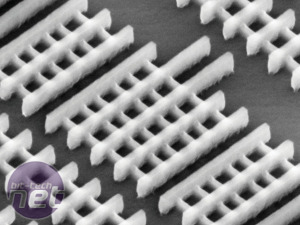Intel launches Ivy Bridge
We could consider reviews as giving manufacturers a free ride - a positive review equals more sales and increased profit. We're already running out of ideas of what to do with Sandy Bridge E, unless you need a rendering station or folding farm, but Intel is seemingly stopping at nothing on its mission to wipe away all competition from the desktop x86 chip market.Picking up from the acclaimed Sandy Bridge architecture, Ivy Bridge will be the first of Intel's chips to use its brand-new 22nm Tri-Gate transistors, promising higher performance, lower TDP or a combination of the two.
In fact, there are rumours that even the top-end Ivy Bridge CPU model will have a TDP of just 77W, compared to 95W from the equivalent Sandy Bridge chips. This will also be the first line-up of Intel CPUs to feature integrated DirectX 11 graphics, potentially rivalling AMD's Llano chips in some areas.
Perhaps more importantly, however, the chips should happily slot into plenty of existing LGA1155 motherboards, providing an easy upgrade path, while also bringing PCI-E 3 support. We expect to see the first Ivy Bridge CPUs appearing around March or April.
AMD deserts the high-end desktop CPU market
There's been a lot of speculation about AMD's future in the desktop CPU market recently, and much of it has been remarkably ill-founded. It all started when AMD's chief technology officer, Mike Silverman, told San Jose Mercury News that 'We're at an inflection point,' adding that 'we will need to let go of the old "AMD versus Intel" mindset, because it won't be about that anymore.'This spun the rumour mill into overdrive, with many journalists who should know better taking it to mean that AMD was planning to exit the desktop CPU market. However, given the colossal amount of money that AMD has invested in fusing GPU and CPU technologies together, and given its lack of any notable tablet and smartphone tech, we reckon this is highly unlikely. It's much more probable that Silverman was just talking about AMD's new focus on GPGPU computing and the low-power end of the CPU market, as opposed to the old days when the company's AMD64 architecture was trouncing Intel's NetBurst chips. This is, after all, the one major benefit that AMD has over Intel right now.
That said, if AMD can no longer compete with Intel in the high-end segment of the desktop CPU market - and the performance of its lamentable Bulldozer processors suggests this is certainly the case - then we wouldn't be surprised to see AMD moving away from this market and instead focusing solely on low-powered processors such as Llano. As Silverman suggested, this isn't moving out of the x86 desktop CPU market altogether, but it's certainly a different focus for the company. By the end of 2012, we would be very surprised if AMD was still talking up its high-end desktop CPUs.

MSI MPG Velox 100R Chassis Review
October 14 2021 | 15:04










Want to comment? Please log in.